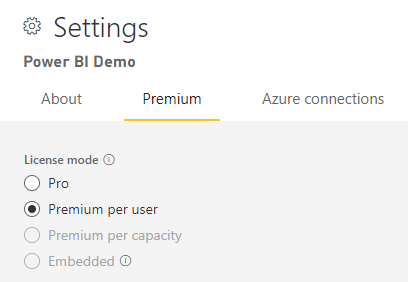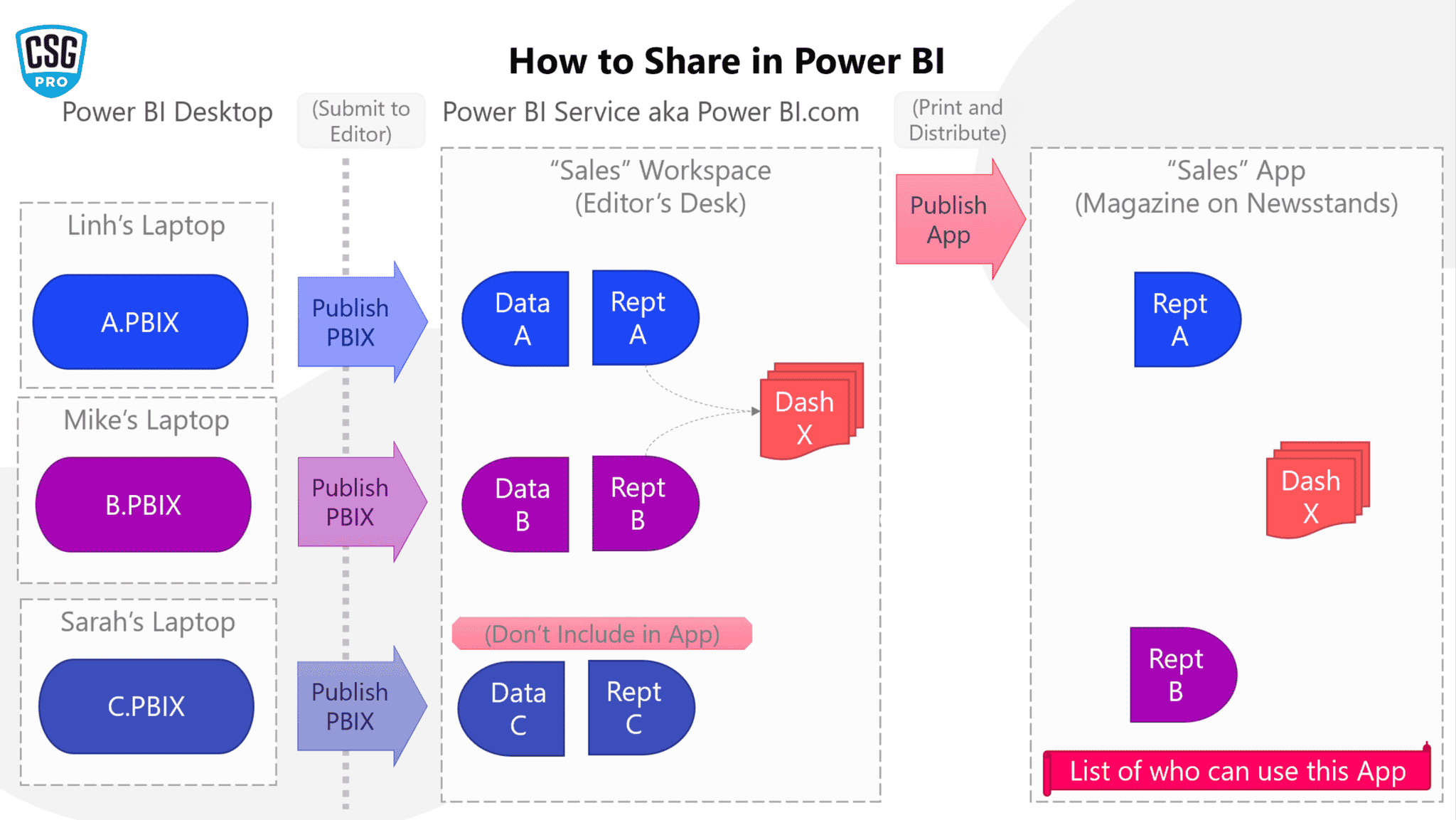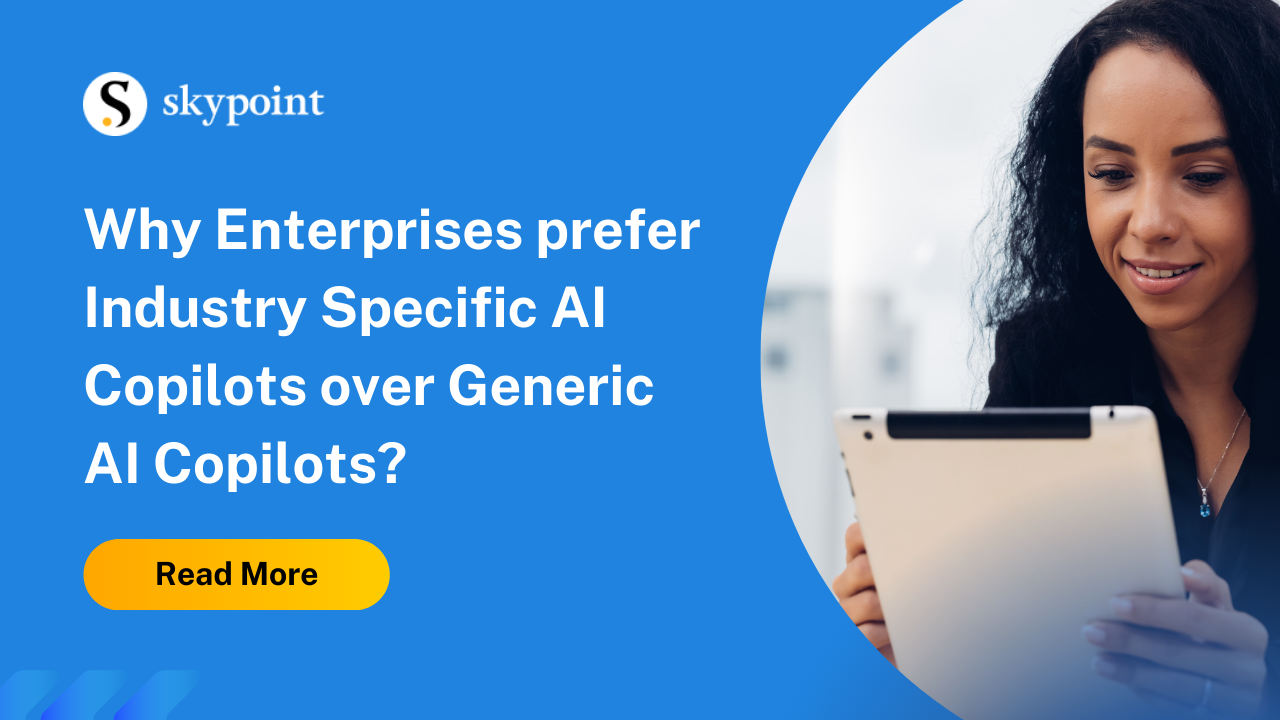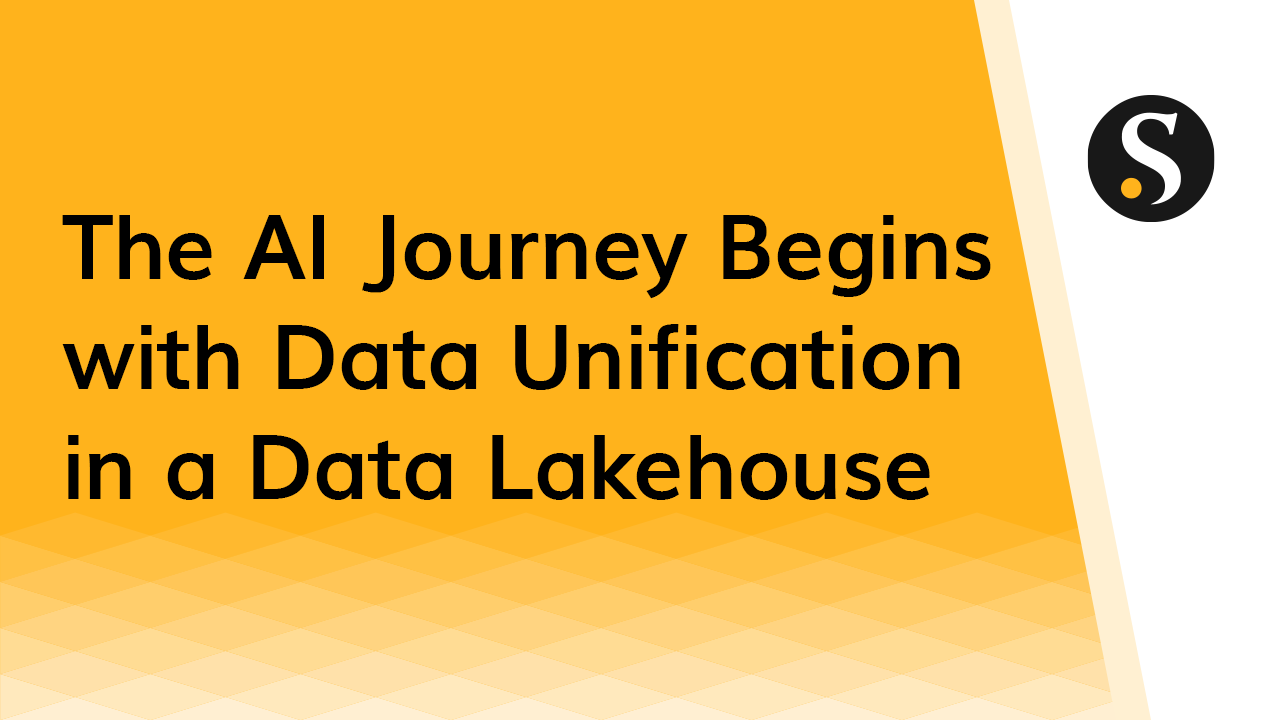Congrats! Your organization has made the decision to pick Power BI as your business intelligence platform of choice. Now it’s time for the rubber to hit the road—figuring out how to roll out the tool for report authors and consumers alike.
Step 1…getting the right Power BI licensing in place.
To have the best possible foundation for collaboration, you need the right tools. Microsoft loves to make licensing flexible but ends up with too many options that are just downright confusing.
This Ultimate Power BI Licensing Guide will help you understand different licensing considerations so you can make an informed decision, get the most bang for your buck, and plan your organization’s Power BI rollout.
Power BI General Guidelines
Before going too deep into licensing, you need to have a high-level understanding of how report distribution works in Power BI.
Here is a graphic to help illustrate the role of using Power BI to:
- Build a report (.PBIX file) with Power BI Desktop.
- Publish the report to PowerBI.com within a container called a Workspace, which we can think of as your development environment (analogous to an Editors Desk).
- And finally, publish the contents of your Workspace to an App for others to consume (Magazine on Newsstands). I will use the terms Workspace and App in this piece very specifically.
Is Power BI Free?
Power BI Desktop is a FREE download and the full-featured authoring tool for Power BI reports. Connect to data sources, build models, and visualize your data without paying a penny. When you save your work, it will be saved as a .PBIX file that you can treat as “source code.”
Nothing is stopping you from emailing or sharing your .PBIX file. But we do NOT recommend using this as your distribution method because there are serious security and versioning concerns. With a .PBIX file you can peer into data source paths, have access to imported data, and so forth.
The Power BI Service (the term for PowerBI.com) also has free capabilities for those with a work, school, or government email. Consumer email does not allow free access.
With a free account, you are provided a “My Workspace” on PowerBI.com where you can publish reports and set up automated data refresh for your own viewing pleasure. The catch is you cannot create an App from My Workspace, but you can share individual reports to others to view if they have a Pro license.
Can You See All Reports With a Free Power BI Account?
Want to share your report with someone else? GOTCHA! That is where Power BI licensing comes into play. The only way you can see other people’s reports with a free Power BI account is with a Premium Workspace or App. Want to share your report publicly for free? No problem!
After you publish to your My Workspace you can Publish to Web for everyone to see. DO NOT take Publish to Web lightly, these reports are truly available to the general public. Your admin has the ability to turn Publish to Web off as a safety measure.
It is very easy for website crawlers to find your public report no matter what you do. However, if it is truly for public consumption, the Publish to Web also provides an embed code if you want to integrate a Power BI report on to your website, blog post, or portal…totally for free.
Publishing and Consuming Reports on the Power BI Service (PowerBI.com)
There are countless reasons to go cloud-first for your BI deployment. On-premises data sources? No problem. With Microsoft’s Power BI Gateway technology you can push data up to the cloud without punching holes in your security firewall or sacrificing performance.
When you purchase Power BI licensing, you are effectively purchasing the cloud-hosted Power BI Service to be able to:
- Create Workspace/Apps as containers for development/consumption (respectively).
- Unlock robust capabilities like Dashboards, Data Alerts, Data Security, Commenting, and much more.
- Edit reports online—and soon—edit data models as well.
Microsoft pushes out monthly updates to both the Power BI Desktop tool and Power BI Service. If you want the most up-to-date capabilities of Power BI, choosing to leverage the Power BI Service is imperative.
Consuming Reports on Your Internal Apps, External Portal, or SaaS Product
Here is where consumption-based flexibility comes in. There are different licensing paths you can take depending on your use case, audience, and volume of users.
Microsoft’s documentation does a great job of giving a high-level comparison of the different consumption-based options. In the next section, I will break down the considerations on why to go one route or another.
Publishing and Consuming Reports On-Prem With Power BI Report Server
Is your organization cloud-averse? Much to my chagrin, Power BI Report Server may be right for you. There are only two ways to purchase Power BI Report Server:
- Purchase (or have already purchased) SQL Server Enterprise edition.
- Purchase Power BI Premium—here is how to get the keys for installation.
Wait… To get Power BI Report Server, I need to buy a huge chunk of cloud capacity for Power BI Premium—just to get the on-premises version?
Yes. Microsoft is helping you make the move to the cloud on “your terms” just to dangle the cloud carrot (ha!).
My main gripes about Power BI Report Server is that it feels like “half a loaf” compared to the Power BI Service AND it has its own version of Power BI Desktop (yikes!).
Power BI Desktop “optimized” for Report Server is several versions behind its cloud counterpart. Every IT Department’s worst nightmare is having to support an organization that has both types of Power BI Desktop and must maintain a common version throughout the org.
Also, don’t get the false sense of security that sticking on-premises is safer. I doubt your security budget can keep up with Microsoft’s continual investment in cloud security. The Power BI Service also provides many data governance options that are enticing like data sensitivity labels.
I deliberately will not be going into considerations for Power BI Report Server in the following sections because this is not a true licensing path. You are either cloud averse, you purchased SQL Server Enterprise edition already, or you’re on a shoe-string budget—which are all valid reasons!
If your organization relies heavily on SQL Server Reporting Services (SSRS), then this is a great option to explore as you move your organization forward from traditional flat reporting to dynamic self-service reporting.
Check out our free Dashboard in a Day Workshops
What Are the Assigned Power BI Licensing Options?
These licenses must be assigned to a named M365 user. You can self-serve and buy these licenses through your M365 Admin Portal and assign them appropriately if you have the right administrator role.
Power BI Free License
Power BI Free is essentially its own type of license. When users log in to PowerBI.com for the first time, they assign themselves a free license and/or start a free Pro trial without even knowing it.
You can turn off the ability for users to self-serve a free license, thus turning off their ability to access PowerBI.com unless they are assigned a free license.

What is the point of a free license? If you have Power BI Premium, that means free users can consume content. That also means they need access to PowerBI.com, unless it is A-SKU Power BI Embedded Premium…more on that below.
Power BI Pro License
A Power BI Pro license is needed for both developers and report consumers to view reports in the Power BI Service in the absence of Power BI Premium. It costs a flat price of $10 per user per month for all the amazing features of the Power BI Service.
Power BI Pro has so much to offer for this price…it is unbelievable. Just look at this comparison chart and notice the only gaps between Pro and Premium are mostly for deployment options, administration, and data science. Notable Power BI Pro features:
- Shared and certified datasets
- Ad-hoc analysis and data exploration with Excel
- Dataflows
- 1 GB datasets / 8 report refreshes per day
- Incremental refresh: Automatically partition and manage dataset tables to optimize refresh schedule.
- Customized “app” experience for end-users
- In-context commenting and collaboration
- AI-powered data visuals out-of-the-box
- And much, much more…
The Power BI Pro license is only included in the E5 enterprise licensing deal if you want a package rate across your Microsoft technologies. If you are E3 or E1, then keep reading.
Going wall-to-wall E5 for all your users has its price benefits, but you will still miss out on Power BI Premium features focused on delivering Enterprise BI (more on this below). But deciding to go E5 means your organization is committed to self-service analytics.
What if my organization is reluctant to purchase Power BI Pro?
Guess what…you can purchase it anyway with the “Buy Now” link without being a tenant admin and set up billing yourself. Go rogue or go home!
Power BI Premium Per User (PPU) License
Power BI Premium Per User (PPU) was a big change to licensing options that went GA in early 2021. Like Power BI Pro, both developers and report consumers need a Power BI Premium Per User License to take advantage of Premium features without a Premium capacity (consumption-based) SKU.
Power BI Premium Per User (PPU) Pricing
This licensing option provides access to Power BI premium features on a per-user basis. Both developers and consumers will need a PPU license to access the premium features.
It costs $20 per user per month if you get it as a standalone license and includes all the features in Power BI Pro. If you already have Power BI Pro, you’d pay an extra $10 to access all the additional features, such as advanced AI and self-service prep for big data.
Power BI Premium Per User is Workspace-specific. And no…you can’t mix and match with Pro or consumption-based tiers. To start using Power BI Premium Per User, all you have to do is create a Workspace then go to your Workspace settings and choose Premium Per User—easy as that!

If you are not seeing this option or it is greyed out, ask your Power BI Admin to enable Premium Per User.

Power BI Capacity-Based License Options
Capacity-based licensing options are a great way to skirt named license management for report consumers and this opens up a world of possibilities/features. A high-level comparison of capacity-based licensing documentation can be found here.
Power BI Capacity-Based Pricing
Ah…the vexing question of calculating your consumption-based compute needs. Whether you are purchasing a cloud data warehouse in Azure (or any other cloud provider) or Power BI Premium, it is extremely difficult to predict your needed expenditure without empirical information. The need for a proof-of-concept (POC) or starting small at first is critical to success.
Estimated prices for Power BI capacity-based licensing (if left on 24/7) are below*. Remember:
- EM SKU must be purchased for the full year.
- A SKU can be variable down to the minute, given the ability to turn off/on (plus added costs for a custom app).
- Like EM SKU, P SKU requires a commitment to an annual license.
| Capacity Nodes | Total V Cores | RAM (GB) | Price per Month* | Price per Year* |
| EM1/A1 | 1 | 2.5 | $735.00 | $8,820.00 |
| EM2/A2 | 2 | 5 | $1,470.00 | $17,640.00 |
| EM3/A3 | 4 | 10 | $2,940.00 | $35,280.00 |
| P1/A4 | 8 | 25 | $4,995.00 | $59,940.00 |
| P2/A5 | 16 | 50 | $9,990.00 | $119,880.00 |
| P3/A6 | 32 | 100 | $19,980.00 | $239,760.00 |
| P4 | 64 | 200 | $39,960.00 | $479,520.00 |
| P5 | 128 | 400 | $79,920.00 | $959,040.00 |
Given the need for empirical information, typically the A-SKU is the best budget option to deploy your reports and test user load and compute metrics or start at P1. Your compute needs depend on a number of variables that are near impossible to calculate for, such as:
- Number of reports
- Complexity of reports
- DAX measures
- Power Query transformations
- Direct or Import mode
- Calculated columns
- Number of users accessing the reports
- The number of visuals on reports and interactivity between pages
- And much more… have I convinced you yet to do a POC?
What does “app owns data” or “user owns data” mean with capacity-based licenses?
An important concept to understand is that the core differentiator between capacity-based licenses is “app owns data” versus “user owns data”.
App Owns Data
Your custom application built to embed Power BI leverages a single service principal Power BI account to authenticate the use of the Power BI Embedded API.
You must use row-level security (RLS) in a multi-tenant type paradigm where one Power BI Premium Workspace serves many clients. Otherwise, you need to have a single-tenant type paradigm where each client has their own Power BI Premium Workspace. The added flexibility to use RLS at the app level is another option—and how I remember what “app owns data” means.
You can use a multitude of authentication methods for your user to access your custom app (Azure AD, third-party services, or your home-grown authentication database).
User Owns Data
Whether you are in the Power BI Service, M365 app, Teams, SharePoint, third-party service, or your own custom application, your embedded Power BI must use a Power BI login (with Azure AD) to authenticate access for your Power BI free users.

Power BI Premium (P SKU)
If you have the budget and want to go all-in on self-service analytics and Enterprise BI features, then Power BI Premium is a no-brainer. You get EVERYTHING…and yes, I mean everything even with the starter P1 SKU.
Typically, I recommend organizations to start incrementally with Pro licenses and Power BI Premium Per User rather than unleash all at once. But no one is stopping you from taking the dive!
What differentiates the decision to go wall-to-wall E5 Power BI Pro licenses versus Power BI Premium? Your organization may have both…and yes, there is a reason for this.
Enabling everyone in the organization to have Power BI Pro licenses is centered around the self-service analytics path from data analysts to business users. Power BI Premium enables so much more, including:
- Data science workloads
- Enhanced BI DevOps features
- Enhanced data flows
- Paginated reports (more details below)
Thus, Power BI Premium extends capabilities out to the data engineer and data scientist while also delivering more robust Enterprise BI capabilities for the rest of the user spectrum.
Here is an image on notable Power BI Premium features that target Enterprise BI needs compared to Power BI Pro:

Power BI Embedding (EM SKU)
In-context analytics for your business applications allows you to embed reports where they make the most impact on workflow (like SharePoint or Teams). Save your users from having to keep a Power BI Service browser window open and navigating away from your line of business applications.
The EM SKU option is narrowly focused and has a yearly commitment, so your use case better be a good one. I rarely run into situations where an EM SKU is the right decision.
Power BI Embedded (A SKU)
Power BI Embedded (A SKU) is specifically offered for building external-facing custom applications. But, this SKU can also be used for internal-facing analytics, which opens up a wealth of options.
Essentially you are buying access to the Power BI Embedded API and choosing to have flexibility on how you authenticate users. If your org has app dev experience with .NET, then you will be happy to learn how lightweight developing an app to embed Power BI reports is.
A SKU is the most economical of Premium options because you have absolute control of your capacity expenditure—like starting and stopping on a whim. But you don’t get any of the luxuries of Power BI Service for report consumers. Here is a post specific to A SKU use.
When you purchase a P SKU, you also get access to the Power BI Embedded API…should you want to build a custom application off your capacity in an “app owns data” or “user owns data” paradigm.
What Does Power BI Premium Really Mean?
Power BI Premium is essentially a Power BI Workspace with “premium capabilities” like these:
- Reserved capacity: No “noisy” neighbors. Your Power BI tenant is on its own dedicated compute server.
- Larger datasets: 1 GB max dataset for Pro and up to 10 GB max dataset for Premium.
- More refreshes: 8 per day for Pro or 48 for Premium.
- Incremental refresh: Automatically partition and manage dataset tables to optimize refresh schedule.
- Paginated reports: Think SSRS but with Power BI visuals and its own development tool.
- Paginated report visual (coming soon): The ability to embed a paginated report in a Power BI report and interact with the visual.
- Power BI Report Server: Already mentioned above.
- Unlimited sharing: UNLEASH THE KRAKEN!!
- Automated insights visual: Combines all Power BI AI functionalities and surfaces details that need your attention.
- Premium dataflows features: What are dataflows? Read this.
- Deployment pipelines and deployment pipeline automation (coming soon).
- Ability to integrate Azure Cognitive Services (EM2, A2, or P1 and above).
- Build machine learning models on top of your Power BI data with AutoML (EM2, A2, or P1 and above).
More new features are coming out soon, including discoverable datasets, optimized reports for mobile devices, deployment into Teams App, new governance functionalities, automatic aggregations, embed Power BI in Jupyter Notebook, and more.
This workspace can either generate a Power BI Premium App (P SKU), embed to organization destinations with user owns data (EM SKU, M365 authenticated user), or embed anywhere with app owns data (A SKU, one service principal user with “choose your own authentication” method).
Premium Gen2, an architecturally redesigned generation of Power BI Premium, will offer Power BI Premium capabilities to all A SKU licenses and additional perks to P SKUs. This updated enterprise-grade capacity-based offering is more scalable. It also helps reduce management overhead and enhance performance.
The new platform integrates with features such as Azure Monitor to deliver a centralized view on Premium Capacity, simplifying the distribution of costs for capacity usage. This helps support better long-term budget planning while allowing you to respond to fast-changing analytics needs.
(Note: This update is currently in preview. It’s available to Premium subscribers right now and is expected to reach general availability in July 2021. All Premium SKUs will move to this model by the end of 2021.)
Power BI Premium is typically referring to the P SKUs when you read posts in the wild. Less common are the EM and A SKUs, although they have equal merit. Here is the link comparing Power BI Pro versus Premium features for reference.
For Your BI Development Team
Your BI Development team will ALWAYS need a Power BI Pro license (yes, even to publish on-premises to Report Server). Yes, the Desktop tool is free to make and open the source code of reports (.PBIX files). But publishing the report outside of “My Workspace” will require a license.
Even if you are using the consumption-based options, authors will need a Power BI Pro license to push reports to the Power BI Service Workspaces where the “App” consumption layer can either be the typical Power BI App, embedded line of business application destinations (like SharePoint or Dynamics), or its own stand-alone embedded application.
Power BI Premium Per User is a great option if your BI developers want to leverage premium features, without the price-tag of going straight to a Power BI Premium P SKU. Premium features your BI team will care about:
- Deployment pipelines (ALM & DevOps)
- 48 report refreshes per day
- 10 GB datasets
- Enhanced dataflows
- Paginated reports
The Power BI Embedded A or EM SKU grants you a workspace with a subset of Premium features at a much lower starting price point than P SKU but requires minimum A/EM levels to unlock certain capabilities. For example with A2/EM2 you can use AutoML in Power BI and will need A4/EM4 for Paginated Reports.
With Power BI Premium Per User, Microsoft manages the scaling of the capacity for you behind the curtains (like Power BI Pro) and you get mostly all the Premium features.
It is worth noting that Power BI Pro and Power BI Premium Per User function are on “shared” capacity in the Microsoft cloud. Thus, they are subject to latency issues if you have “noisy” neighbors. Power BI Premium provides dedicated capacity if you are extremely latency conscious.
________________________
Flexibility with a lot of options is a double-edged sword. On one hand, you can mix and match to fit your exact needs, but there are so many considerations even for what seems like the smallest decisions.
Take an incremental and empirical approach to choose the right Power BI licensing. Focus on these four variables: volume, audience, features, and use case with a roadmap for scale.
Still not sure? Schedule time to chat about the right Power BI licensing path for your organization.
Register for our Free Power BI Workshops












